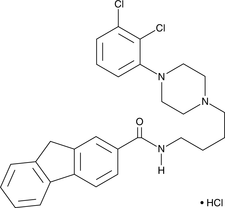Chemicals
Showing 29101–29250 of 41137 results
-
Netilimicin is an aminoglycoside antibiotic.{47386} It is active against S. aureus, N. gonorrhoeae, E. coli, P. mirabilis, and P. aeruginosa (MICs = 0.4, 3.1, 0.8, 1.6, and 0.4 µg/ml, respectively) as well as Enterococci, Enterobacter, Citrobacter, and Klebsiella species (MICs = 3.1, 0.4, 0.8, and ≤0.2 µg/ml, respectively). Netilimicin induces nephrotoxicity in rats when administered at doses ranging from 50 to 150 mg/kg.{47387} It also induces neuromuscular block, decreasing twitch tension in isolated diaphragm and soleus muscles in rabbits (ED50s = 18.5 and 62.2 mg/kg, respectively).{47388} Formulations containing netilimicin were previously used in the intravenous treatment of severe bacterial infections.
Brand:CaymanSKU:26666 - 10 mgAvailable on backorder
Netilimicin is an aminoglycoside antibiotic.{47386} It is active against S. aureus, N. gonorrhoeae, E. coli, P. mirabilis, and P. aeruginosa (MICs = 0.4, 3.1, 0.8, 1.6, and 0.4 µg/ml, respectively) as well as Enterococci, Enterobacter, Citrobacter, and Klebsiella species (MICs = 3.1, 0.4, 0.8, and ≤0.2 µg/ml, respectively). Netilimicin induces nephrotoxicity in rats when administered at doses ranging from 50 to 150 mg/kg.{47387} It also induces neuromuscular block, decreasing twitch tension in isolated diaphragm and soleus muscles in rabbits (ED50s = 18.5 and 62.2 mg/kg, respectively).{47388} Formulations containing netilimicin were previously used in the intravenous treatment of severe bacterial infections.
Brand:CaymanSKU:26666 - 100 mgAvailable on backorder
Netilimicin is an aminoglycoside antibiotic.{47386} It is active against S. aureus, N. gonorrhoeae, E. coli, P. mirabilis, and P. aeruginosa (MICs = 0.4, 3.1, 0.8, 1.6, and 0.4 µg/ml, respectively) as well as Enterococci, Enterobacter, Citrobacter, and Klebsiella species (MICs = 3.1, 0.4, 0.8, and ≤0.2 µg/ml, respectively). Netilimicin induces nephrotoxicity in rats when administered at doses ranging from 50 to 150 mg/kg.{47387} It also induces neuromuscular block, decreasing twitch tension in isolated diaphragm and soleus muscles in rabbits (ED50s = 18.5 and 62.2 mg/kg, respectively).{47388} Formulations containing netilimicin were previously used in the intravenous treatment of severe bacterial infections.
Brand:CaymanSKU:26666 - 25 mgAvailable on backorder
Netilimicin is an aminoglycoside antibiotic.{47386} It is active against S. aureus, N. gonorrhoeae, E. coli, P. mirabilis, and P. aeruginosa (MICs = 0.4, 3.1, 0.8, 1.6, and 0.4 µg/ml, respectively) as well as Enterococci, Enterobacter, Citrobacter, and Klebsiella species (MICs = 3.1, 0.4, 0.8, and ≤0.2 µg/ml, respectively). Netilimicin induces nephrotoxicity in rats when administered at doses ranging from 50 to 150 mg/kg.{47387} It also induces neuromuscular block, decreasing twitch tension in isolated diaphragm and soleus muscles in rabbits (ED50s = 18.5 and 62.2 mg/kg, respectively).{47388} Formulations containing netilimicin were previously used in the intravenous treatment of severe bacterial infections.
Brand:CaymanSKU:26666 - 50 mgAvailable on backorder
Netupitant is an insurmountable antagonist of the neurokinin-1 (NK1) receptor (Ki = 0.95 nM in CHO cells expressing the human recombinant receptor).{37265} It is selective for human NK1 over human NK2 and NK3 and rat NK1 (Kis = >1,500 nM) and over 50 G protein-coupled receptors, monoamine transporters, and ion channels when used in the nanomolar range.{37266} Netupitant decreases the maximal response to substance P-induced contractions in isolated guinea pig ileum with long-lasting effects. It also dose-dependently inhibits the substance P-induced scratching, biting, and licking response in mice when used at doses ranging from 1-10 mg/kg and decreases NK agonist-induced foot tapping in gerbils (ID50s = 1.5 mg/kg, i.p., or 0.5 mg/kg, oral). Formulations containing netupitant have been used in the treatment of chemotherapy-induced nausea and vomiting.
Brand:CaymanSKU:23809 - 10 mgAvailable on backorder
Netupitant is an insurmountable antagonist of the neurokinin-1 (NK1) receptor (Ki = 0.95 nM in CHO cells expressing the human recombinant receptor).{37265} It is selective for human NK1 over human NK2 and NK3 and rat NK1 (Kis = >1,500 nM) and over 50 G protein-coupled receptors, monoamine transporters, and ion channels when used in the nanomolar range.{37266} Netupitant decreases the maximal response to substance P-induced contractions in isolated guinea pig ileum with long-lasting effects. It also dose-dependently inhibits the substance P-induced scratching, biting, and licking response in mice when used at doses ranging from 1-10 mg/kg and decreases NK agonist-induced foot tapping in gerbils (ID50s = 1.5 mg/kg, i.p., or 0.5 mg/kg, oral). Formulations containing netupitant have been used in the treatment of chemotherapy-induced nausea and vomiting.
Brand:CaymanSKU:23809 - 25 mgAvailable on backorder
Netupitant is an insurmountable antagonist of the neurokinin-1 (NK1) receptor (Ki = 0.95 nM in CHO cells expressing the human recombinant receptor).{37265} It is selective for human NK1 over human NK2 and NK3 and rat NK1 (Kis = >1,500 nM) and over 50 G protein-coupled receptors, monoamine transporters, and ion channels when used in the nanomolar range.{37266} Netupitant decreases the maximal response to substance P-induced contractions in isolated guinea pig ileum with long-lasting effects. It also dose-dependently inhibits the substance P-induced scratching, biting, and licking response in mice when used at doses ranging from 1-10 mg/kg and decreases NK agonist-induced foot tapping in gerbils (ID50s = 1.5 mg/kg, i.p., or 0.5 mg/kg, oral). Formulations containing netupitant have been used in the treatment of chemotherapy-induced nausea and vomiting.
Brand:CaymanSKU:23809 - 50 mgAvailable on backorder
Netupitant-d6 is intended for use as an internal standard for the quantification of netupitant (Item No. 23809) by GC- or LC-MS. Netupitant is an insurmountable antagonist of the neurokinin-1 (NK1) receptor (Ki = 0.95 nM in CHO cells expressing the human recombinant receptor).{37265} It is selective for human NK1 over human NK2 and NK3 and rat NK1 (Kis = >1,500 nM) and over 50 G protein-coupled receptors, monoamine transporters, and ion channels when used in the nanomolar range.{37266} Netupitant decreases the maximal response to substance P-induced contractions in isolated guinea pig ileum with long-lasting effects. It also dose-dependently inhibits the substance P-induced scratching, biting, and licking response in mice when used at doses ranging from 1 to 10 mg/kg and decreases NK agonist-induced foot tapping in gerbils (ID50s = 1.5 mg/kg, i.p., or 0.5 mg/kg, oral).
Brand:CaymanSKU:28901 - 1 mgAvailable on backorder
Neurodazine induces neuronal differentiation in skeletal muscle cells.{17109} In mouse C2C12 myoblasts, neurodazine (2 μM for seven days) upregulated the expression of neuron-specific enolase (NSE), neurofilament 200 (NF200), synapsin, and other neuronal markers. Neurodazine similarly upregulated NSE and NF200 in human skeletal muscle fibers, indicating efficacy in mature muscle as well as in myoblasts.
Brand:CaymanSKU:-Neurodazine induces neuronal differentiation in skeletal muscle cells.{17109} In mouse C2C12 myoblasts, neurodazine (2 μM for seven days) upregulated the expression of neuron-specific enolase (NSE), neurofilament 200 (NF200), synapsin, and other neuronal markers. Neurodazine similarly upregulated NSE and NF200 in human skeletal muscle fibers, indicating efficacy in mature muscle as well as in myoblasts.
Brand:CaymanSKU:-Neurodazine induces neuronal differentiation in skeletal muscle cells.{17109} In mouse C2C12 myoblasts, neurodazine (2 μM for seven days) upregulated the expression of neuron-specific enolase (NSE), neurofilament 200 (NF200), synapsin, and other neuronal markers. Neurodazine similarly upregulated NSE and NF200 in human skeletal muscle fibers, indicating efficacy in mature muscle as well as in myoblasts.
Brand:CaymanSKU:-Neurodazine induces neuronal differentiation in skeletal muscle cells.{17109} In mouse C2C12 myoblasts, neurodazine (2 μM for seven days) upregulated the expression of neuron-specific enolase (NSE), neurofilament 200 (NF200), synapsin, and other neuronal markers. Neurodazine similarly upregulated NSE and NF200 in human skeletal muscle fibers, indicating efficacy in mature muscle as well as in myoblasts.
Brand:CaymanSKU:-Neuropeptide FF (NPFF) is a peptide expressed in the brain and spinal cord that shares a precursor protein with neuropeptide AF.{38823} NPFF is expressed primarily in the posterior pituitary, hypothalamus, and medulla. It is an agonist at NPFF1 and NPFF2 receptors (Kis = 2.82 and 0.21 nM, respectively, for human recombinant receptors) that inhibits forskolin-induced cAMP production in CHO cells (EC50s = 236 and 2.3 nM, respectively).{38824} NPFF activates parvocellular neurons in the paraventricular nucleus (PVN) of the hypothalamus to stimulate oxytocin release from their projections in the brain stem, thereby regulating baroreflex control of heart rate.{38825} However, it inhibits magnocellular PVN neurons by enhancing GABAergic input. It is also found in plasma and exogenous administration briefly increases mean arterial pressure (MAP) by 40 mm Hg in rats, an effect that is only partially blocked by the norepinephrine competitor guanethidine (Item No. 16217) and the α1-adrenergic receptor antagonist prazosin (Item No. 15023).{38826} NPFF has anti-opioid effects in rodent models, inhibiting morphine-induced analgesia and inducing abstinence in morphine-tolerant rats.{38823,38827} It also inhibits acquisition of conditioned place preference to cocaine in rats when administered at doses of 10 and 20 nmol.{38828}
Brand:CaymanSKU:24548 - 1 mgAvailable on backorder
Neuropeptide S is a neuropeptide that is an agonist of the neuropeptide S receptor (NPSR) with an EC50 value of 3.2 nM for the rat peptide to induce intracellular calcium mobilization in HEK293 cells expressing the human receptor.{14301} In rats, it increases the duration of wakefulness and decreases slow wave sleep stage 1 (SWS1), SWS2, and rapid eye movement (REM). Neuropeptide S dose-dependently (0.5-4 nmol per animal, i.c.v.) decreases fecal pellet excretion induced by restraint stress or corticotropin releasing factor (CRF) but does not influence basal gastric emptying, gastrointestinal transit, or distal colon propulsion.{40683} It also inhibits audible and ultrasonic vocalizations and increases the percentage of time spent in the open arm of the elevated plus maze test in a mouse model of arthritis.{40684}
Brand:CaymanSKU:24148 - 1 mgAvailable on backorder
Neuropeptide Y (NPY) is a peptide abundantly distributed throughout the central and peripheral nervous systems that plays a major role in controlling appetite, blood pressure, cardiac contractility, and intestinal secretion.{5565} Five subtypes of the NPY receptor have been identified. Subtypes Y1 and Y5 have known roles in the stimulation of feeding while Y2 and Y4 seem to have roles in satiety.{5565} NPY has also been shown to interact with the immune system, promoting gastrointestinal inflammation, as well as exhibiting an antimicrobial effect against several gut bacteria.{24276}
Brand:CaymanSKU:-Neuropeptide Y (NPY) is a peptide abundantly distributed throughout the central and peripheral nervous systems that plays a major role in controlling appetite, blood pressure, cardiac contractility, and intestinal secretion.{5565} Five subtypes of the NPY receptor have been identified. Subtypes Y1 and Y5 have known roles in the stimulation of feeding while Y2 and Y4 seem to have roles in satiety.{5565} NPY has also been shown to interact with the immune system, promoting gastrointestinal inflammation, as well as exhibiting an antimicrobial effect against several gut bacteria.{24276}
Brand:CaymanSKU:-Neuropeptide Y (NPY) is a peptide abundantly distributed throughout the central and peripheral nervous systems that plays a major role in controlling appetite, blood pressure, cardiac contractility, and intestinal secretion.{5565} Five subtypes of the NPY receptor have been identified. Subtypes Y1 and Y5 have known roles in the stimulation of feeding while Y2 and Y4 seem to have roles in satiety.{5565} NPY has also been shown to interact with the immune system, promoting gastrointestinal inflammation, as well as exhibiting an antimicrobial effect against several gut bacteria.{24276}
Brand:CaymanSKU:-Neutrophil elastase is stored within cytoplasmic azurophilic granules in the neutrophil and released upon stimulation by pathogens where it acts either as free protein or is associated with neutrophil extracellular traps (NETs). Together with other proteases released from activated neutrophils, neutrophil elastase plays a critical role in degrading invading pathogens and thus provides the earliest line of defense in the immune system. Neutrophil elastase inhibitor is an N-benzoylindazole derivative that selectively targets the binding domain of neutrophil elastase (IC50 = 7 nM).{23600} It has been shown to inhibit additional serine proteases, thrombin and urokinase, only at higher, micromolar concentrations (IC50s = 1.9 and 6.6 µM, respectively).{23600}
Brand:CaymanSKU:-Neutrophil elastase is stored within cytoplasmic azurophilic granules in the neutrophil and released upon stimulation by pathogens where it acts either as free protein or is associated with neutrophil extracellular traps (NETs). Together with other proteases released from activated neutrophils, neutrophil elastase plays a critical role in degrading invading pathogens and thus provides the earliest line of defense in the immune system. Neutrophil elastase inhibitor is an N-benzoylindazole derivative that selectively targets the binding domain of neutrophil elastase (IC50 = 7 nM).{23600} It has been shown to inhibit additional serine proteases, thrombin and urokinase, only at higher, micromolar concentrations (IC50s = 1.9 and 6.6 µM, respectively).{23600}
Brand:CaymanSKU:-Neutrophil elastase is stored within cytoplasmic azurophilic granules in the neutrophil and released upon stimulation by pathogens where it acts either as free protein or is associated with neutrophil extracellular traps (NETs). Together with other proteases released from activated neutrophils, neutrophil elastase plays a critical role in degrading invading pathogens and thus provides the earliest line of defense in the immune system. Neutrophil elastase inhibitor is an N-benzoylindazole derivative that selectively targets the binding domain of neutrophil elastase (IC50 = 7 nM).{23600} It has been shown to inhibit additional serine proteases, thrombin and urokinase, only at higher, micromolar concentrations (IC50s = 1.9 and 6.6 µM, respectively).{23600}
Brand:CaymanSKU:-Neutrophil elastase is stored within cytoplasmic azurophilic granules in the neutrophil and released upon stimulation by pathogens where it acts either as free protein or is associated with neutrophil extracellular traps (NETs). Together with other proteases released from activated neutrophils, neutrophil elastase plays a critical role in degrading invading pathogens and thus provides the earliest line of defense in the immune system. Neutrophil elastase inhibitor is an N-benzoylindazole derivative that selectively targets the binding domain of neutrophil elastase (IC50 = 7 nM).{23600} It has been shown to inhibit additional serine proteases, thrombin and urokinase, only at higher, micromolar concentrations (IC50s = 1.9 and 6.6 µM, respectively).{23600}
Brand:CaymanSKU:-Nevirapine is a non-nucleoside reverse transcriptase inhibitor (NNRTI).{22819} It binds to HIV-1 reverse transcriptase and inhibits RNA plus-strand initiation (IC50 = 0.45 μM). Nevirapine prevents seroconversion and viremia in a chimpanzee model of HIV-1 infection.{49140} Formulations containing nevirapine have been used in combination therapy for the treatment of HIV-1 infection.
Brand:CaymanSKU:-Nevirapine is a non-nucleoside reverse transcriptase inhibitor (NNRTI).{22819} It binds to HIV-1 reverse transcriptase and inhibits RNA plus-strand initiation (IC50 = 0.45 μM). Nevirapine prevents seroconversion and viremia in a chimpanzee model of HIV-1 infection.{49140} Formulations containing nevirapine have been used in combination therapy for the treatment of HIV-1 infection.
Brand:CaymanSKU:-Nevirapine is a non-nucleoside reverse transcriptase inhibitor (NNRTI).{22819} It binds to HIV-1 reverse transcriptase and inhibits RNA plus-strand initiation (IC50 = 0.45 μM). Nevirapine prevents seroconversion and viremia in a chimpanzee model of HIV-1 infection.{49140} Formulations containing nevirapine have been used in combination therapy for the treatment of HIV-1 infection.
Brand:CaymanSKU:-Nevirapine is a non-nucleoside reverse transcriptase inhibitor (NNRTI).{22819} It binds to HIV-1 reverse transcriptase and inhibits RNA plus-strand initiation (IC50 = 0.45 μM). Nevirapine prevents seroconversion and viremia in a chimpanzee model of HIV-1 infection.{49140} Formulations containing nevirapine have been used in combination therapy for the treatment of HIV-1 infection.
Brand:CaymanSKU:-Nevirapine-d4 is intended for use as an internal standard for the quantification of nevirapine (Item No. 15117) by GC- or LC-MS. Nevirapine is a non-nucleoside reverse transcriptase inhibitor (NNRTI).{22819} It binds to HIV-1 reverse transcriptase and inhibits RNA plus-strand initiation (IC50 = 0.45 μM). Nevirapine prevents seroconversion and viremia in a chimpanzee model of HIV-1 infection.{49140} Formulations containing nevirapine have been used in combination therapy for the treatment of HIV-1 infection.
Brand:CaymanSKU:28093 - 1 mgAvailable on backorder
Nevirapine-d4 is intended for use as an internal standard for the quantification of nevirapine (Item No. 15117) by GC- or LC-MS. Nevirapine is a non-nucleoside reverse transcriptase inhibitor (NNRTI).{22819} It binds to HIV-1 reverse transcriptase and inhibits RNA plus-strand initiation (IC50 = 0.45 μM). Nevirapine prevents seroconversion and viremia in a chimpanzee model of HIV-1 infection.{49140} Formulations containing nevirapine have been used in combination therapy for the treatment of HIV-1 infection.
Brand:CaymanSKU:28093 - 5 mgAvailable on backorder
Nexinhib20 is an inhibitor of the protein-protein interaction between the small GTPase Rab27a and its effector JFC1 (IC50 = 2.6 µM).{46766} It inhibits myeloperoxidase (MPO) secretion induced by granulocyte macrophage colony-stimulating factor (GM-CSF) and fMLP in isolated human neutrophils (IC50 = 0.33 µM). Nexinhib20 (30 mg/kg) reduces LPS-induced increases in plasma MPO levels, as well as LPS-induced hepatic and renal neutrophil infiltration in a mouse model of endotoxin-induced systemic inflammation.
Brand:CaymanSKU:29899 - 1 mgAvailable on backorder
Nexinhib20 is an inhibitor of the protein-protein interaction between the small GTPase Rab27a and its effector JFC1 (IC50 = 2.6 µM).{46766} It inhibits myeloperoxidase (MPO) secretion induced by granulocyte macrophage colony-stimulating factor (GM-CSF) and fMLP in isolated human neutrophils (IC50 = 0.33 µM). Nexinhib20 (30 mg/kg) reduces LPS-induced increases in plasma MPO levels, as well as LPS-induced hepatic and renal neutrophil infiltration in a mouse model of endotoxin-induced systemic inflammation.
Brand:CaymanSKU:29899 - 10 mgAvailable on backorder
Nexinhib20 is an inhibitor of the protein-protein interaction between the small GTPase Rab27a and its effector JFC1 (IC50 = 2.6 µM).{46766} It inhibits myeloperoxidase (MPO) secretion induced by granulocyte macrophage colony-stimulating factor (GM-CSF) and fMLP in isolated human neutrophils (IC50 = 0.33 µM). Nexinhib20 (30 mg/kg) reduces LPS-induced increases in plasma MPO levels, as well as LPS-induced hepatic and renal neutrophil infiltration in a mouse model of endotoxin-induced systemic inflammation.
Brand:CaymanSKU:29899 - 25 mgAvailable on backorder
Nexinhib20 is an inhibitor of the protein-protein interaction between the small GTPase Rab27a and its effector JFC1 (IC50 = 2.6 µM).{46766} It inhibits myeloperoxidase (MPO) secretion induced by granulocyte macrophage colony-stimulating factor (GM-CSF) and fMLP in isolated human neutrophils (IC50 = 0.33 µM). Nexinhib20 (30 mg/kg) reduces LPS-induced increases in plasma MPO levels, as well as LPS-induced hepatic and renal neutrophil infiltration in a mouse model of endotoxin-induced systemic inflammation.
Brand:CaymanSKU:29899 - 5 mgAvailable on backorder
Nexturastat A is a potent inhibitor of HDAC6 (IC50 = 5.02 nM) that displays high selectivity over all other HDACs.{29222} It dose-dependently induces hyperacetylation of α-tubulin in B16 murine melanoma cells without elevating histone H3 acetylation.{29222} Nexturastat A is cell-permeable and inhibits the proliferation of B16 cells (GI50 = 14.3 µM).{29222}
Brand:CaymanSKU:-Out of stock
Nexturastat A is a potent inhibitor of HDAC6 (IC50 = 5.02 nM) that displays high selectivity over all other HDACs.{29222} It dose-dependently induces hyperacetylation of α-tubulin in B16 murine melanoma cells without elevating histone H3 acetylation.{29222} Nexturastat A is cell-permeable and inhibits the proliferation of B16 cells (GI50 = 14.3 µM).{29222}
Brand:CaymanSKU:-Out of stock
Nexturastat A is a potent inhibitor of HDAC6 (IC50 = 5.02 nM) that displays high selectivity over all other HDACs.{29222} It dose-dependently induces hyperacetylation of α-tubulin in B16 murine melanoma cells without elevating histone H3 acetylation.{29222} Nexturastat A is cell-permeable and inhibits the proliferation of B16 cells (GI50 = 14.3 µM).{29222}
Brand:CaymanSKU:-Out of stock
Nexturastat A is a potent inhibitor of HDAC6 (IC50 = 5.02 nM) that displays high selectivity over all other HDACs.{29222} It dose-dependently induces hyperacetylation of α-tubulin in B16 murine melanoma cells without elevating histone H3 acetylation.{29222} Nexturastat A is cell-permeable and inhibits the proliferation of B16 cells (GI50 = 14.3 µM).{29222}
Brand:CaymanSKU:-Out of stock
Matrix metalloproteinase-9 (MMP-9), via activation by TNF-α, plays a key role in tumor invasion and metastasis. NF-κB activation inhibitor III is a compound that inhibits TNF-α-induced MMP-9 protein expression (maximal effect at 10 µM) by blocking NF-κB activity in HT1080 human fibrosarcoma cells.{30517} It has been used to disrupt NF-κB signaling in order to study the role of syndecans in mediating extracellular matrix integrity.{30518}
Brand:CaymanSKU:-Available on backorder
Matrix metalloproteinase-9 (MMP-9), via activation by TNF-α, plays a key role in tumor invasion and metastasis. NF-κB activation inhibitor III is a compound that inhibits TNF-α-induced MMP-9 protein expression (maximal effect at 10 µM) by blocking NF-κB activity in HT1080 human fibrosarcoma cells.{30517} It has been used to disrupt NF-κB signaling in order to study the role of syndecans in mediating extracellular matrix integrity.{30518}
Brand:CaymanSKU:-Available on backorder
NF-κB inhibitor (Item No. 17493) is a synthetic peptide corresponding to the nuclear localization sequence (NLS) of NF-κB p105 subunit (also known as p50) appended to a hydrophobic sequence to facilitate import into living cells.{17866} It blocks the nuclear import of p105 in cells treated with activators of NF-κB signaling, including LPS and TNF-α.{17866} NF-κB control is a peptide that is identical in sequence to NF-κB inhibitor, except two essential, basic residues of the p105 NLS are substituted with non-basic amino acids.{17866} It is ineffective at blocking the activation of NF-κB signaling and is used as a negative control peptide.{17866,28515,28513}
Brand:CaymanSKU:-Available on backorder
NF-κB inhibitor (Item No. 17493) is a synthetic peptide corresponding to the nuclear localization sequence (NLS) of NF-κB p105 subunit (also known as p50) appended to a hydrophobic sequence to facilitate import into living cells.{17866} It blocks the nuclear import of p105 in cells treated with activators of NF-κB signaling, including LPS and TNF-α.{17866} NF-κB control is a peptide that is identical in sequence to NF-κB inhibitor, except two essential, basic residues of the p105 NLS are substituted with non-basic amino acids.{17866} It is ineffective at blocking the activation of NF-κB signaling and is used as a negative control peptide.{17866,28515,28513}
Brand:CaymanSKU:-Available on backorder
NF-κB inhibitor (Item No. 17493) is a synthetic peptide corresponding to the nuclear localization sequence (NLS) of NF-κB p105 subunit (also known as p50) appended to a hydrophobic sequence to facilitate import into living cells.{17866} It blocks the nuclear import of p105 in cells treated with activators of NF-κB signaling, including LPS and TNF-α.{17866} NF-κB control is a peptide that is identical in sequence to NF-κB inhibitor, except two essential, basic residues of the p105 NLS are substituted with non-basic amino acids.{17866} It is ineffective at blocking the activation of NF-κB signaling and is used as a negative control peptide.{17866,28515,28513}
Brand:CaymanSKU:-Available on backorder
NF-κB inhibitor is a synthetic peptide corresponding to the nuclear localization sequence of NF-κB p105 subunit (also known as p50) appended to a hydrophobic sequence to facilitate import into living cells.{17866} It blocks the nuclear import of p105 in cells treated with activators of NF-κB signaling, including LPS and TNF-α.{17866} In this way, NF-κB inhibitor blocks gene expression that is regulated by NF-κB.{28516,28514} This peptide is commonly used to evaluate the role of NF-κB signaling in cellular responses.{28518,28517}
Brand:CaymanSKU:-Available on backorder
NF-κB inhibitor is a synthetic peptide corresponding to the nuclear localization sequence of NF-κB p105 subunit (also known as p50) appended to a hydrophobic sequence to facilitate import into living cells.{17866} It blocks the nuclear import of p105 in cells treated with activators of NF-κB signaling, including LPS and TNF-α.{17866} In this way, NF-κB inhibitor blocks gene expression that is regulated by NF-κB.{28516,28514} This peptide is commonly used to evaluate the role of NF-κB signaling in cellular responses.{28518,28517}
Brand:CaymanSKU:-Available on backorder
NF-κB inhibitor is a synthetic peptide corresponding to the nuclear localization sequence of NF-κB p105 subunit (also known as p50) appended to a hydrophobic sequence to facilitate import into living cells.{17866} It blocks the nuclear import of p105 in cells treated with activators of NF-κB signaling, including LPS and TNF-α.{17866} In this way, NF-κB inhibitor blocks gene expression that is regulated by NF-κB.{28516,28514} This peptide is commonly used to evaluate the role of NF-κB signaling in cellular responses.{28518,28517}
Brand:CaymanSKU:-Available on backorder
NF449 is an analog of suramin that selectively inhibits P2X1 purinergic receptors (pIC50 = 6.3) with a potency 19-fold greater than at P2X3, P2Y1, P2Y2, or P2Y11.{23042,23041} Through selective inhibition of the P2X1 receptor, 10 mg/kg NF449 has been used to decrease intravascular platelet aggregation in a mouse model of systemic thromboembolism.{23040} NF449 has also demonstrated selective antagonism of the Gsα-subunit G protein, which suppresses the association rate of GTPγS binding to Gsα-s, inhibits the stimulation of adenylyl cyclase activity, and blocks G protein coupling to certain GPCRs.{23039}
Brand:CaymanSKU:-NF449 is an analog of suramin that selectively inhibits P2X1 purinergic receptors (pIC50 = 6.3) with a potency 19-fold greater than at P2X3, P2Y1, P2Y2, or P2Y11.{23042,23041} Through selective inhibition of the P2X1 receptor, 10 mg/kg NF449 has been used to decrease intravascular platelet aggregation in a mouse model of systemic thromboembolism.{23040} NF449 has also demonstrated selective antagonism of the Gsα-subunit G protein, which suppresses the association rate of GTPγS binding to Gsα-s, inhibits the stimulation of adenylyl cyclase activity, and blocks G protein coupling to certain GPCRs.{23039}
Brand:CaymanSKU:-NF449 is an analog of suramin that selectively inhibits P2X1 purinergic receptors (pIC50 = 6.3) with a potency 19-fold greater than at P2X3, P2Y1, P2Y2, or P2Y11.{23042,23041} Through selective inhibition of the P2X1 receptor, 10 mg/kg NF449 has been used to decrease intravascular platelet aggregation in a mouse model of systemic thromboembolism.{23040} NF449 has also demonstrated selective antagonism of the Gsα-subunit G protein, which suppresses the association rate of GTPγS binding to Gsα-s, inhibits the stimulation of adenylyl cyclase activity, and blocks G protein coupling to certain GPCRs.{23039}
Brand:CaymanSKU:-NF449 is an analog of suramin that selectively inhibits P2X1 purinergic receptors (pIC50 = 6.3) with a potency 19-fold greater than at P2X3, P2Y1, P2Y2, or P2Y11.{23042,23041} Through selective inhibition of the P2X1 receptor, 10 mg/kg NF449 has been used to decrease intravascular platelet aggregation in a mouse model of systemic thromboembolism.{23040} NF449 has also demonstrated selective antagonism of the Gsα-subunit G protein, which suppresses the association rate of GTPγS binding to Gsα-s, inhibits the stimulation of adenylyl cyclase activity, and blocks G protein coupling to certain GPCRs.{23039}
Brand:CaymanSKU:-NFAT activation inhibitor III is a cell-permeant inhibitor of signaling through nuclear factor of activated T cells (NFAT).{21639} It binds the substrate recognition site of the phosphatase calcineurin (Kd = 0.8 µM), preventing it from binding and dephosphorylating NFAT.{21639} NFAT activation inhibitor III blocks the nuclear import of NFAT in T cells stimulated with ionomycin (Item No. 10004974). It prevents the induced expression of cytokine mRNAs in T cells stimulated with phorbol ester and ionomycin.{21639}
Brand:CaymanSKU:21812 -Out of stock
NFAT activation inhibitor III is a cell-permeant inhibitor of signaling through nuclear factor of activated T cells (NFAT).{21639} It binds the substrate recognition site of the phosphatase calcineurin (Kd = 0.8 µM), preventing it from binding and dephosphorylating NFAT.{21639} NFAT activation inhibitor III blocks the nuclear import of NFAT in T cells stimulated with ionomycin (Item No. 10004974). It prevents the induced expression of cytokine mRNAs in T cells stimulated with phorbol ester and ionomycin.{21639}
Brand:CaymanSKU:21812 -Out of stock
NFAT activation inhibitor III is a cell-permeant inhibitor of signaling through nuclear factor of activated T cells (NFAT).{21639} It binds the substrate recognition site of the phosphatase calcineurin (Kd = 0.8 µM), preventing it from binding and dephosphorylating NFAT.{21639} NFAT activation inhibitor III blocks the nuclear import of NFAT in T cells stimulated with ionomycin (Item No. 10004974). It prevents the induced expression of cytokine mRNAs in T cells stimulated with phorbol ester and ionomycin.{21639}
Brand:CaymanSKU:21812 -Out of stock
NFAT activation inhibitor III is a cell-permeant inhibitor of signaling through nuclear factor of activated T cells (NFAT).{21639} It binds the substrate recognition site of the phosphatase calcineurin (Kd = 0.8 µM), preventing it from binding and dephosphorylating NFAT.{21639} NFAT activation inhibitor III blocks the nuclear import of NFAT in T cells stimulated with ionomycin (Item No. 10004974). It prevents the induced expression of cytokine mRNAs in T cells stimulated with phorbol ester and ionomycin.{21639}
Brand:CaymanSKU:21812 -Out of stock
The nuclear factor of activated T cells (NFAT) is a member of the REL family of transcription factors that is involved in regulating transcription of proinflammatory genes, including IL-2 and TNF-α. Calcineurin-mediated dephosphorylation promotes translocation of NFAT proteins into the nucleus, where they bind specific elements within target gene promoters, in many cases through association with other transcription factors such as AP-1, NFκB, MEF-2, and PPARγ. Molecules that interfere with this signaling pathway have potential to be effective in regulating immunosuppressive and anti-inflammatory responses. NFAT inhibitor is a cell-permeable compound that selectively inhibits calcineurin-mediated dephosphorylation of NFAT.{21639,21640,7199} At 100 μM, this inhibitor effectively blocks calcineurin binding to NFAT without disrupting other calcineurin-dependent pathways, unlike the immunosuppressants cyclosporin A and FK506 (Item No. 10007965) which indiscriminately block all calcineurin phosphatase activity.{21639,7199} NFAT inhibitor can disrupt NFAT-dependent expression of IL-2 and TNF-α when transfected in Jurak T cells and can prevent the activation and proliferation of T cells both in vitro (~ 43% at 1 µM using mixed lymphocyte cultures) and in vivo (10 mg/kg using C3H/HeN mice).{7199}
Brand:CaymanSKU:-The nuclear factor of activated T cells (NFAT) is a member of the REL family of transcription factors that is involved in regulating transcription of proinflammatory genes, including IL-2 and TNF-α. Calcineurin-mediated dephosphorylation promotes translocation of NFAT proteins into the nucleus, where they bind specific elements within target gene promoters, in many cases through association with other transcription factors such as AP-1, NFκB, MEF-2, and PPARγ. Molecules that interfere with this signaling pathway have potential to be effective in regulating immunosuppressive and anti-inflammatory responses. NFAT inhibitor is a cell-permeable compound that selectively inhibits calcineurin-mediated dephosphorylation of NFAT.{21639,21640,7199} At 100 μM, this inhibitor effectively blocks calcineurin binding to NFAT without disrupting other calcineurin-dependent pathways, unlike the immunosuppressants cyclosporin A and FK506 (Item No. 10007965) which indiscriminately block all calcineurin phosphatase activity.{21639,7199} NFAT inhibitor can disrupt NFAT-dependent expression of IL-2 and TNF-α when transfected in Jurak T cells and can prevent the activation and proliferation of T cells both in vitro (~ 43% at 1 µM using mixed lymphocyte cultures) and in vivo (10 mg/kg using C3H/HeN mice).{7199}
Brand:CaymanSKU:-The nuclear factor of activated T cells (NFAT) is a member of the REL family of transcription factors that is involved in regulating transcription of proinflammatory genes, including IL-2 and TNF-α. Calcineurin-mediated dephosphorylation promotes translocation of NFAT proteins into the nucleus, where they bind specific elements within target gene promoters, in many cases through association with other transcription factors such as AP-1, NFκB, MEF-2, and PPARγ. Molecules that interfere with this signaling pathway have potential to be effective in regulating immunosuppressive and anti-inflammatory responses. NFAT inhibitor is a cell-permeable compound that selectively inhibits calcineurin-mediated dephosphorylation of NFAT.{21639,21640,7199} At 100 μM, this inhibitor effectively blocks calcineurin binding to NFAT without disrupting other calcineurin-dependent pathways, unlike the immunosuppressants cyclosporin A and FK506 (Item No. 10007965) which indiscriminately block all calcineurin phosphatase activity.{21639,7199} NFAT inhibitor can disrupt NFAT-dependent expression of IL-2 and TNF-α when transfected in Jurak T cells and can prevent the activation and proliferation of T cells both in vitro (~ 43% at 1 µM using mixed lymphocyte cultures) and in vivo (10 mg/kg using C3H/HeN mice).{7199}
Brand:CaymanSKU:-NFF-3 is a fluorogenic substrate of matrix metalloproteinases (MMPs).{37000} NFF-3 is hydrolyzed rapidly by MMP-3 (kcat/Km = 218,000 s-1*M-1) and slowly by MMP-9 (kcat/Km = 10,100 s-1*M-1) with no significant hydrolysis by MMP-1 or MMP-2.{37000} NFF-3 can be used to differentiate MMP-3 activity from that of other MMPs.{37000, 37001}
Brand:CaymanSKU:22188 -Out of stock
NFF-3 is a fluorogenic substrate of matrix metalloproteinases (MMPs).{37000} NFF-3 is hydrolyzed rapidly by MMP-3 (kcat/Km = 218,000 s-1*M-1) and slowly by MMP-9 (kcat/Km = 10,100 s-1*M-1) with no significant hydrolysis by MMP-1 or MMP-2.{37000} NFF-3 can be used to differentiate MMP-3 activity from that of other MMPs.{37000, 37001}
Brand:CaymanSKU:22188 -Out of stock
NG 012 is a fungal metabolite originally isolated from P. verruculosum that has fungicidal and nerve growth factor-potentiating properties.{45185,45186} It inhibits the growth of the plant pathogenic fungi B. cinerea, P. teres, P. lingam, S. sclerotiorum, and M. fructigena in vitro.{45185} NG 012 (50 μM) increases the efficacy of the antifungal miconazole (Item No. 15420) against C. albicans, reducing the IC50 value from 19.2 to 2.5 μM.{45187} It also potentiates neurite outgrowth induced by nerve growth factor (NGF) in PC12 cells in a concentration-dependent manner.{45186}
Brand:CaymanSKU:27509 - 1 mgAvailable on backorder
NG 012 is a fungal metabolite originally isolated from P. verruculosum that has fungicidal and nerve growth factor-potentiating properties.{45185,45186} It inhibits the growth of the plant pathogenic fungi B. cinerea, P. teres, P. lingam, S. sclerotiorum, and M. fructigena in vitro.{45185} NG 012 (50 μM) increases the efficacy of the antifungal miconazole (Item No. 15420) against C. albicans, reducing the IC50 value from 19.2 to 2.5 μM.{45187} It also potentiates neurite outgrowth induced by nerve growth factor (NGF) in PC12 cells in a concentration-dependent manner.{45186}
Brand:CaymanSKU:27509 - 5 mgAvailable on backorder
NG 012 is a fungal metabolite originally isolated from P. verruculosum that has fungicidal and nerve growth factor-potentiating properties.{45185,45186} It inhibits the growth of the plant pathogenic fungi B. cinerea, P. teres, P. lingam, S. sclerotiorum, and M. fructigena in vitro.{45185} NG 012 (50 μM) increases the efficacy of the antifungal miconazole (Item No. 15420) against C. albicans, reducing the IC50 value from 19.2 to 2.5 μM.{45187} It also potentiates neurite outgrowth induced by nerve growth factor (NGF) in PC12 cells in a concentration-dependent manner.{45186}
Brand:CaymanSKU:27509 - 500 µgAvailable on backorder
NG 52 is a tri-substituted purine that binds to the ATP-binding site of yeast cyclin-dependent kinases, inhibiting Cdc28p and Pho85p (IC50s = 7 and 2 µM, respectively).{6960} It is ineffective against the yeast kinases Kin28p, Srb10, and Cak1p. NG 52 is cell permeable and inhibits the growth of S. cerevisiae (GI50 = 30 µM).{6960} It is an analog of purvalanol A (Item No. 14579), a potent inhibitor of mammalian cyclin-dependent kinases.{6960}
Brand:CaymanSKU:-Available on backorder
NG 52 is a tri-substituted purine that binds to the ATP-binding site of yeast cyclin-dependent kinases, inhibiting Cdc28p and Pho85p (IC50s = 7 and 2 µM, respectively).{6960} It is ineffective against the yeast kinases Kin28p, Srb10, and Cak1p. NG 52 is cell permeable and inhibits the growth of S. cerevisiae (GI50 = 30 µM).{6960} It is an analog of purvalanol A (Item No. 14579), a potent inhibitor of mammalian cyclin-dependent kinases.{6960}
Brand:CaymanSKU:-Available on backorder
NG 52 is a tri-substituted purine that binds to the ATP-binding site of yeast cyclin-dependent kinases, inhibiting Cdc28p and Pho85p (IC50s = 7 and 2 µM, respectively).{6960} It is ineffective against the yeast kinases Kin28p, Srb10, and Cak1p. NG 52 is cell permeable and inhibits the growth of S. cerevisiae (GI50 = 30 µM).{6960} It is an analog of purvalanol A (Item No. 14579), a potent inhibitor of mammalian cyclin-dependent kinases.{6960}
Brand:CaymanSKU:-Available on backorder
NG 52 is a tri-substituted purine that binds to the ATP-binding site of yeast cyclin-dependent kinases, inhibiting Cdc28p and Pho85p (IC50s = 7 and 2 µM, respectively).{6960} It is ineffective against the yeast kinases Kin28p, Srb10, and Cak1p. NG 52 is cell permeable and inhibits the growth of S. cerevisiae (GI50 = 30 µM).{6960} It is an analog of purvalanol A (Item No. 14579), a potent inhibitor of mammalian cyclin-dependent kinases.{6960}
Brand:CaymanSKU:-Available on backorder
NG-amino-L-Arginine inhibits nNOS, iNOS, and eNOS with Ki values of 0.3, 3, and 2.5 μM, respectively.{18431,18432} Inhibition is mediated by covalent alteration of the heme prosthetic group leading to inactivation of the enzyme.{18431,18432,18434} NG-amino-L-Arginine can be used both in cell culture and in vivo.{18433,18430}
Brand:CaymanSKU:10554 - 10 mgAvailable on backorder
NG-amino-L-Arginine inhibits nNOS, iNOS, and eNOS with Ki values of 0.3, 3, and 2.5 μM, respectively.{18431,18432} Inhibition is mediated by covalent alteration of the heme prosthetic group leading to inactivation of the enzyme.{18431,18432,18434} NG-amino-L-Arginine can be used both in cell culture and in vivo.{18433,18430}
Brand:CaymanSKU:10554 - 25 mgAvailable on backorder
NG-amino-L-Arginine inhibits nNOS, iNOS, and eNOS with Ki values of 0.3, 3, and 2.5 μM, respectively.{18431,18432} Inhibition is mediated by covalent alteration of the heme prosthetic group leading to inactivation of the enzyme.{18431,18432,18434} NG-amino-L-Arginine can be used both in cell culture and in vivo.{18433,18430}
Brand:CaymanSKU:10554 - 5 mgAvailable on backorder
NG-amino-L-Arginine inhibits nNOS, iNOS, and eNOS with Ki values of 0.3, 3, and 2.5 μM, respectively.{18431,18432} Inhibition is mediated by covalent alteration of the heme prosthetic group leading to inactivation of the enzyme.{18431,18432,18434} NG-amino-L-Arginine can be used both in cell culture and in vivo.{18433,18430}
Brand:CaymanSKU:10554 - 50 mgAvailable on backorder
NG,NG-dimethyl-L-Arginine (ADMA) is an endogenous nitric oxide synthase inhibitor. ADMA concentrations increase in several disease states including renal failure, muscular dystrophy, hypercholesterolemia, and pregnancy with preeclampsia, but its precise role in these diseases has not been elucidated.{822,4517,3249,6637}
Brand:CaymanSKU:80230 - 10 mgAvailable on backorder
NG,NG-dimethyl-L-Arginine (ADMA) is an endogenous nitric oxide synthase inhibitor. ADMA concentrations increase in several disease states including renal failure, muscular dystrophy, hypercholesterolemia, and pregnancy with preeclampsia, but its precise role in these diseases has not been elucidated.{822,4517,3249,6637}
Brand:CaymanSKU:80230 - 25 mgAvailable on backorder
NG,NG-dimethyl-L-Arginine (ADMA) is an endogenous nitric oxide synthase inhibitor. ADMA concentrations increase in several disease states including renal failure, muscular dystrophy, hypercholesterolemia, and pregnancy with preeclampsia, but its precise role in these diseases has not been elucidated.{822,4517,3249,6637}
Brand:CaymanSKU:80230 - 5 mgAvailable on backorder
NG,NG-dimethyl-L-Arginine (ADMA) is an endogenous nitric oxide synthase inhibitor. ADMA concentrations increase in several disease states including renal failure, muscular dystrophy, hypercholesterolemia, and pregnancy with preeclampsia, but its precise role in these diseases has not been elucidated.{822,4517,3249,6637}
Brand:CaymanSKU:80230 - 50 mgAvailable on backorder
NGB 2904 is an antagonist that is selective for the dopamine D3 receptor (Ki = 1.4 nM).{34177} It potently inhibits quinpirole-stimulated mitogenesis (IC50 = 6.8 nM).{34174} NGB 2904 attenuates cocaine- and stress-induced reinstatement of drug-seeking behavior in rats.{34173,34176} It also increases spontaneous and amphetamine-stimulated locomotion in mice.{34175}
Brand:CaymanSKU:21457 -Out of stock
NGB 2904 is an antagonist that is selective for the dopamine D3 receptor (Ki = 1.4 nM).{34177} It potently inhibits quinpirole-stimulated mitogenesis (IC50 = 6.8 nM).{34174} NGB 2904 attenuates cocaine- and stress-induced reinstatement of drug-seeking behavior in rats.{34173,34176} It also increases spontaneous and amphetamine-stimulated locomotion in mice.{34175}
Brand:CaymanSKU:21457 -Out of stock
NGB 2904 is an antagonist that is selective for the dopamine D3 receptor (Ki = 1.4 nM).{34177} It potently inhibits quinpirole-stimulated mitogenesis (IC50 = 6.8 nM).{34174} NGB 2904 attenuates cocaine- and stress-induced reinstatement of drug-seeking behavior in rats.{34173,34176} It also increases spontaneous and amphetamine-stimulated locomotion in mice.{34175}
Brand:CaymanSKU:21457 -Out of stock
NGI 1 is an oligosaccharyltransferase (OST) inhibitor.{57264} It binds to and stabilizes the STT3B catalytic subunit of OST in a cellular thermal shift assay (CETSA) and inhibits N-linked glycosylation in a reporter assay using D54 ER-LucT cells (IC50 = 1.1 µM). NGI 1 (10 µM) reduces glycosylation and membrane localization of EGFR in H3255 lung adenocarcinoma cells and inhibits proliferation of PC-9 and A549 non-small cell lung cancer (NSCLC) cells. It inhibits dengue and Zika virus replication in HEK293 cells (EC50s = 0.85 and 2.2 µM, respectively).{57265} NGI 1 also reduces viral RNA in HEK293 cells infected with West Nile virus or yellow fever virus.
Brand:CaymanSKU:31519 - 10 mgAvailable on backorder
NGI 1 is an oligosaccharyltransferase (OST) inhibitor.{57264} It binds to and stabilizes the STT3B catalytic subunit of OST in a cellular thermal shift assay (CETSA) and inhibits N-linked glycosylation in a reporter assay using D54 ER-LucT cells (IC50 = 1.1 µM). NGI 1 (10 µM) reduces glycosylation and membrane localization of EGFR in H3255 lung adenocarcinoma cells and inhibits proliferation of PC-9 and A549 non-small cell lung cancer (NSCLC) cells. It inhibits dengue and Zika virus replication in HEK293 cells (EC50s = 0.85 and 2.2 µM, respectively).{57265} NGI 1 also reduces viral RNA in HEK293 cells infected with West Nile virus or yellow fever virus.
Brand:CaymanSKU:31519 - 25 mgAvailable on backorder
NGI 1 is an oligosaccharyltransferase (OST) inhibitor.{57264} It binds to and stabilizes the STT3B catalytic subunit of OST in a cellular thermal shift assay (CETSA) and inhibits N-linked glycosylation in a reporter assay using D54 ER-LucT cells (IC50 = 1.1 µM). NGI 1 (10 µM) reduces glycosylation and membrane localization of EGFR in H3255 lung adenocarcinoma cells and inhibits proliferation of PC-9 and A549 non-small cell lung cancer (NSCLC) cells. It inhibits dengue and Zika virus replication in HEK293 cells (EC50s = 0.85 and 2.2 µM, respectively).{57265} NGI 1 also reduces viral RNA in HEK293 cells infected with West Nile virus or yellow fever virus.
Brand:CaymanSKU:31519 - 5 mgAvailable on backorder
NGI 1 is an oligosaccharyltransferase (OST) inhibitor.{57264} It binds to and stabilizes the STT3B catalytic subunit of OST in a cellular thermal shift assay (CETSA) and inhibits N-linked glycosylation in a reporter assay using D54 ER-LucT cells (IC50 = 1.1 µM). NGI 1 (10 µM) reduces glycosylation and membrane localization of EGFR in H3255 lung adenocarcinoma cells and inhibits proliferation of PC-9 and A549 non-small cell lung cancer (NSCLC) cells. It inhibits dengue and Zika virus replication in HEK293 cells (EC50s = 0.85 and 2.2 µM, respectively).{57265} NGI 1 also reduces viral RNA in HEK293 cells infected with West Nile virus or yellow fever virus.
Brand:CaymanSKU:31519 - 50 mgAvailable on backorder
NGP-555 is a modulator of γ-secretase that inhibits APP intracellular signaling domain (AICD) cleavage to amyloid-β (Aβ; IC50s = 531 and 131 nM for Aβ40 and Aβ42, respectively, in HeLa cell membranes).{48964} It is selective for AICD cleavage to Aβ over E-cadherin and Notch cleavage to their signaling effectors, E-cadherin γ-C-terminal fragment and NICD, respectively, processes also mediated by γ-secretase, when used at a concentration of 30 µM. Dietary administration of NGP-555 (~50 mg/kg per day) reduces cortical and hippocampal plaque area in the Tg2576 transgenic mouse model of Alzheimer’s disease.{48964} NGP-555 (25 mg/kg per day, p.o.) decreases plasma and brain Aβ40 and Aβ42 levels, as well as increases spontaneous alternations in the Y-maze, indicating prevention of memory deficits, in Tg2576 mice.{35879}
Brand:CaymanSKU:27918 - 1 mgAvailable on backorder
NGP-555 is a modulator of γ-secretase that inhibits APP intracellular signaling domain (AICD) cleavage to amyloid-β (Aβ; IC50s = 531 and 131 nM for Aβ40 and Aβ42, respectively, in HeLa cell membranes).{48964} It is selective for AICD cleavage to Aβ over E-cadherin and Notch cleavage to their signaling effectors, E-cadherin γ-C-terminal fragment and NICD, respectively, processes also mediated by γ-secretase, when used at a concentration of 30 µM. Dietary administration of NGP-555 (~50 mg/kg per day) reduces cortical and hippocampal plaque area in the Tg2576 transgenic mouse model of Alzheimer’s disease.{48964} NGP-555 (25 mg/kg per day, p.o.) decreases plasma and brain Aβ40 and Aβ42 levels, as well as increases spontaneous alternations in the Y-maze, indicating prevention of memory deficits, in Tg2576 mice.{35879}
Brand:CaymanSKU:27918 - 10 mgAvailable on backorder
NGP-555 is a modulator of γ-secretase that inhibits APP intracellular signaling domain (AICD) cleavage to amyloid-β (Aβ; IC50s = 531 and 131 nM for Aβ40 and Aβ42, respectively, in HeLa cell membranes).{48964} It is selective for AICD cleavage to Aβ over E-cadherin and Notch cleavage to their signaling effectors, E-cadherin γ-C-terminal fragment and NICD, respectively, processes also mediated by γ-secretase, when used at a concentration of 30 µM. Dietary administration of NGP-555 (~50 mg/kg per day) reduces cortical and hippocampal plaque area in the Tg2576 transgenic mouse model of Alzheimer’s disease.{48964} NGP-555 (25 mg/kg per day, p.o.) decreases plasma and brain Aβ40 and Aβ42 levels, as well as increases spontaneous alternations in the Y-maze, indicating prevention of memory deficits, in Tg2576 mice.{35879}
Brand:CaymanSKU:27918 - 5 mgAvailable on backorder

























